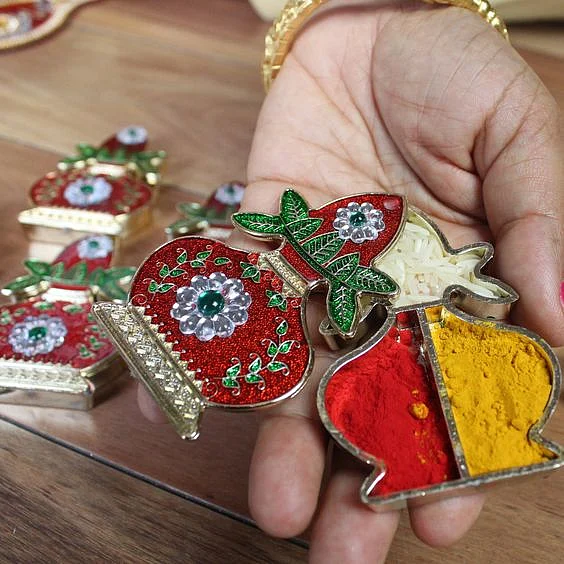Kalash Sthapna, also known as Ghatasthapana, is a highly important ritual during the nine-day festival of Navratri. Placing the Kalash or pot in front of the divine power Maa Durga represents a significant symbolism.

This is performed to seek Mother's blessings and serves as a humble plea to the Devi to answer all prayers. In order to prepare for Kalash sthapna, it is necessary to purchase Navratri puja kits online from a trusted puja store, ensuring that everything is set before Pandit Ji's arrival.
Kalash Sthapana: Rituals To Keep In Mind

Placing Kalash | Pinterest
Assign a location close to your puja area for the Kalash to be placed.

placing 9 types of grains |
Place nine types of grains on a red chowk or red cloth over which the kalash sthapana will take place.

Haldi-Kumkum holder | Pinterest
Use a copper or brass Kalash and put turmeric and vermilion on it. Devotees consider this a common practice that brings good fortune.

placing coconut in kalash | Pinterest
Pour water into the Kalash and place 5 mango leaves together at one end of the Kalash and carefully place the coconut on the Kalash

placing the prepared kalash on the place of puja | Pinterest
Next, position the Kalash onto the wooden board (chowki).

Kalash puja | Pinterest
Why Is Coconut Used In Kalash Puja?
Hindu ceremonies and worship hold great symbolic significance. There is a hidden significance in every ritual. Coconuts are present at most important events. Indeed, smashing coconuts by hand is a frequently seen tradition because it represents the shattering of one's ego.
This is a requirement for reaching wisdom and knowledge. During Navratri, a red cloth or thread is used to wrap the coconut, as it is believed to be sacred in tradition. Once the puja rituals are completed, followers utilise the coconut to prepare prasads, which are served as sweets.
Shardiya Navratri 2024: Ghatasthapana Rules To Follow
Ghatasthapana marks the beginning of the nine-day festival of Navratri. It is the ritual of invocation of Goddess Shakti. It is believed that performing Ghatasthapana at the wrong time can bring the wrath of the Goddess Shakti. Moreover, performing the ritual is prohibited during Amavasya and nighttime. The most auspicious period to do Ghatasthapana is during the first one-third of the day while Pratipada is prevailing. One can also perform the rituals during Abhijit Muhurta.










